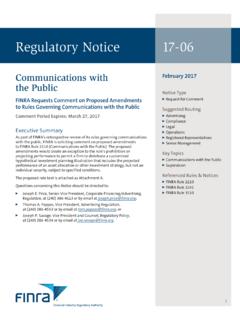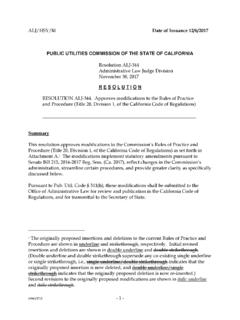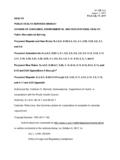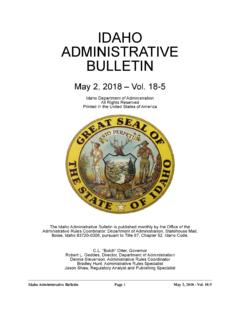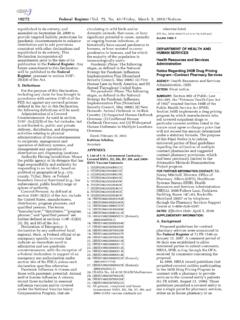Transcription of [INSERT DATE 30 DAYS FROM DATE ADDRESSES: …
1 This draft document is a pre-publication document that may be revised without public notice prior to signature. EPA is providing this document solely for the convenience of interested parties and to seek informal public input. It is not a proposed rule for purposes of public comment under the Administrative Procedure Act, and it is not a rule for purposes of compliance. This document is not disseminated for purposes of EPA's Information Quality Guidelines and does not represent an Agency determination or policy. Sometime in the future, a signed, official version of this document will be published in the Federal Register (FR) and appear on the Government Printing Office's FDsys website ( ) and on ( ) in Docket No. EPA-HQ-OA-2018-0107. Once the official version of this document is published in the FR, this STAFF DRAFT will be removed from the Internet and replaced with a link to the official version.
2 [Billing Code] ENVIRONMENTAL PROTECTION AGENCY 40 CFR Ch. I [EPA-HQ-OA-2018-0107; FRL-XXXX] RIN 2010-AA12 Increasing Consistency and Transparency in Considering Costs and Benefits in the Rulemaking Process AGENCY: Environmental Protection Agency (EPA) ACTION: Advance notice of proposed rulemaking. SUMMARY: EPA promulgates regulations under authority provided in the federal environmental statutes such as the Clean Air Act (CAA), Clean Water Act (CWA), Safe Drinking Water Act (SDWA), and many others. Most statutory provisions require or allow some consideration of cost and benefits when setting pollution standards, but there is variation in terminology and specificity provided in each law regarding the nature and scope of the cost and benefit considerations.
3 In this advance notice of proposed rulemaking (ANPRM), EPA is soliciting comment on whether and how EPA should promulgate regulations that provide a consistent and transparent interpretation relating to the consideration of weighing costs and benefits in making regulatory decisions in a manner consistent with applicable authorizing statutes. EPA is also soliciting comment on whether and how these regulations, if promulgated, could also prescribe specific analytic approaches to quantifying the costs and benefits of EPA regulations. This ANPRM does not propose any regulatory requirements. DATES: Comments must be received on or before [INSERT DATE 30 DAYS FROM DATE OR PUBLICATION IN THE FEDERAL REGISTER]. ADDRESSES: Submit your comments, identified by Docket ID No.
4 EPA-HQ-OA-2018-0107 at Follow the online instructions for submitting comments. Once submitted, comments cannot be edited or removed from EPA may publish any comment received to its public docket. Do not submit electronically any information you consider to be Confidential Business Information (CBI) or other information whose disclosure is ANPRM 2010-AA12 Pre-Publication 2 restricted by statute. Multimedia submissions (audio, video, etc.) must be accompanied by a written comment. The written comment is considered the official comment and should include discussion of all points you wish to make. EPA will generally not consider comments or comment contents located outside of the primary submission ( on the web, cloud, or other file sharing system). For additional submission methods, the full EPA public comment policy, information about CBI or multimedia submissions, and general guidance on making effective comments, please visit FOR FURTHER INFORMATION CONTACT: For further information on this document, please contact National Center for Environmental Economics, Office of Policy, 1200 Pennsylvania Avenue NW.
5 , Mail Code 1809T, Washington, DC 20460, Phone: (202) xxx-xxxx; SUPPLEMENTARY INFORMATION: This notice is organized as follows: I. Background II. Topics for Which EPA Is Seeking Input A. The nature of potential problems of inconsistency and lack of transparency B. Possible approaches for increasing consistency and transparency in considering costs and benefits in the rulemaking process C. Potential for issuing regulations to govern EPA s approach in future rulemakings III. Statutory and Executive Order Review I. Background EPA promulgates regulations to protect public health and the environment under authority provided in the federal environmental statutes that it implements, such as the CAA, CWA, SDWA, and many others. The specific authorities given to the Administrator are established in various sections and subsections of each statute, which range from broad authority ( , to protect public health with an adequate margin of safety) to detailed requirements that specify standards or require that standards be at least as stringent as the best controlled similar source.
6 In addition to legislative direction, regulatory agencies also take direction from the President and the Office of Management and Budget within the Executive Office of the President regarding what type of formal regulatory evaluation should be performed during rulemaking. For decades, Presidents have issued orders providing instruction to agencies concerning the consideration of benefits and costs in regulatory Executive Order 12866, Regulatory Planning and Review, requires an assessment of benefits and costs for all significant regulatory actions with benefits and costs expressed in quantitative terms to the extent feasible and instructs agencies 1 This became more formalized in 1981 with Executive Order 12291 which required executive agencies to perform a cost-benefit analysis for all major rules and centralized the regulatory review process by directing the Office of Management and Budget (OMB)
7 To serve as a central clearinghouse for the review of agency regulations. ANPRM 2010-AA12 Pre-Publication 3 that, to the extent permitted by law, regulatory actions should have benefits that justify their costs (58 FR 51735, October 4, 1993).2 OMB s Circular A-43 and EPA s Guidelines for Preparing Economic Analyses4 provides the Agency with peer-reviewed guidance on how to conduct the analysis of regulatory actions to comply with 12866 and other executive orders and statutory requirements ( , Small Business Regulatory Enforcement Fairness Act of 1996 considerations). EPA's Guidelines establish a scientific framework for analyzing the benefits, costs, and economic impacts of regulations and policies, including assessing the distribution of costs and benefits among various segments of the population.
8 They incorporate recent advances in theoretical and applied work in the field of environmental In this ANPRM, EPA is taking comment on the role that regulatory analysis or aspects of that analysis play in decision making consistent with statutory direction, not what these existing guidance documents recommend about how best to conduct the underlying analysis of regulatory actions. Most statutory provisions require or allow some consideration of cost and benefits when setting regulatory standards to achieve public health and environmental benefits, but there can be a significant variation in terminology and specificity provided in each law regarding the nature and scope of cost and benefit considerations. For example, Section 301 of the CWA instructs the Administrator to select the best available technology economically achievable (33 1311(b)(2)(A)), and then requires EPA to take into account the cost of achieving effluent reductions when assessing best available technology (33 1314(b)(2)(B)).
9 Section 111 of the CAA, however, requires the Administrator to set standards of performance for reducing air pollution (42 7411), defined as the best system of emission reduction which (taking into account the cost of achieving such reduction and any non-air quality health and environmental impact and energy requirements) the Administrator determines has been adequately demonstrated (42 111(a)(1)). Other provisions may only implicitly direct EPA to consider costs, alone or in conjunction with benefits and other factors, or be silent on whether costs should or may be considered. Virtually all environmental statutes leave the specifics on how costs and benefits are to be considered to EPA. The Agency interprets the terms used in the relevant statute and decides how best to weigh costs against benefits and other factors in making regulatory decisions.
10 A few statutory provisions require that specific metrics ( , particular price changes) be included among the costs to be considered (see , Federal Insecticide, Fungicide, and Rodenticide Act 2 Over the past decade, the estimated costs and benefits resulting from EPA regulations have been the highest within the federal government. See Table 1-1 of the Office of Information and Regulatory Affairs (OIRA) 2017 Draft Report to Congress on the Benefits and Costs of Federal Regulations and Agency Compliance with Unfunded Mandates Reform Act. 3 4 5 All chapters undergo an external peer review prior to finalization, either through the EPA s Science Advisory Board Environmental Economics Advisory Committee or through independent reviews by external experts.)










